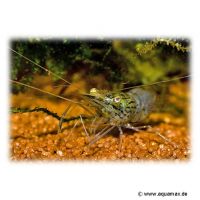Glass Shrimp (Macrobrachium lanchesteri)
| Glass Shrimp Macrobrachium lanchesteri | |
|---|---|
| Name | Glass Shrimp |
| Name Lat. | Macrobrachium lanchesteri |
| Synonym | Riceland Prawn |
| Family | Palaemonid Shrimps |
| Family lat. | Palaemonidae |
| Order | Decapoda |
| Order lat. | Decapoda |
| Origin | Southeast Asia |
| Habitat | Streams, ponds |
| Diet | Detritus, algae, shrimp food |
| pH | 6.0-7.5 |
| Behavior | ♂ territorial |
| Keeping | Harem |
| Care Level | Easy |
| Reproduction | Larval stages |
| Breeding | Difficult |
| Life Span | 2-4 years |
| Protection | No |
| Metric Units | |
| Size | 5-7 cm |
| Temperature | 20-30 °C |
| Hardness | 5-15 °dH |
| Aquarium | 60 l |
| US Units | |
| Size | 2"-2.8" |
| Temperature | 68-86 °F |
| Hardness | 89-267 ppm |
| Aquarium | 15 gal |
Distribution and habitat
The distribution area of the glass shrimp is Malaysia, Thailand and Myanmar. They live in stagnant and slow flowing waters, such as streams, rice fields, irrigation ditches and fish ponds with dense vegetation.
Maintenance
They need a well-structured aquarium with many roots, some robust plants and large stones as well as a moderate current. The substrate of sand or gravel should be partially covered with foliage (e.g. sea almond leaves, oak leaves).
No ammonia, ammonium and nitrite should be detectable in the aquarium water, the nitrate value should not exceed 100 mg/l. To ensure water quality and oxygen content, a filter and heater adapted to the size of the aquarium is required, as well as lighting for the species-appropriate day-night rhythm of the animals. When choosing the filter, special care should be taken to ensure that the animals cannot be sucked in.
Diet
They feed on animal organisms, carrion, snails and dead plant material (sea almond leaves). The diet consists of a combination of live or frozen foods, such as cyclops, daphnia, mosquito larvae, artemia, mysis and tubifex, or a commercial frozen special food mix supplemented with dry foods (tablets, granules) for crayfish and shrimp. Occasionally, slow and weakened fish are also preyed upon.
Regular and varied feeding promotes health and prevents deficiency symptoms. Unaccepted food must be removed after 2-3 hours
Behaviour and compatibility
They should be kept in a harem, one male with several females and are well suited for a community tank with not too small fish. Males behave territorially within the species. Keeping multiple harems is only recommended in larger and richly structured tanks.
Basically, only compatible animals with similar demands on water quality and water temperature should be kept together
Reproduction and breeding
The males have slightly larger claws than the females. Breeding is difficult as they go through several larval stages where they float freely in the water and do not hunt for food independently. The young must be fed several times a day with special rearing food, such as Artemia nauplii or fine dry or frozen food. After about 4 weeks the young animals start to live on the bottom.
Important
The glass shrimp tolerates low temperatures very poorly, but is able to survive low pH and oxygen levels as well as high temperatures up to over 30° C for a short time. It was one of the first shrimp species imported to Europe for keeping in aquariums.
The foliage (sea almond tree, oak, beech, etc.) not only provides cover, but when rotting promotes the development of microorganisms, which are a valuable secondary food source
The well-being of the animals should be monitored regularly. Temperature should be checked daily, pH, hardness and nitrate levels at least every 14 days. Regular partial water changes are recommended, even when contaminant levels have not yet reached the upper limit. Sudden changes in water quality should be avoided. Newly introduced animals must be accustomed slowly to the water in the aquarium.
Further literature can be found in your pet store
References
Text: petdata; Image: www.aquamax.de
Source: KARGE & KLOTZ (2007): Süßwassergarnelen aus aller Welt, Dähne Verlag; ENGELMANN & LANGE (2011): Zootierhaltung - Tiere in menschlicher Obhut: Wirbellose, Verlag Harri Deutsch
